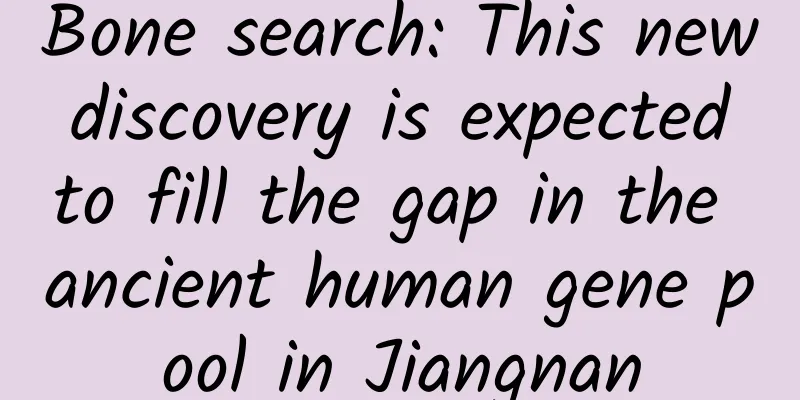Bone search: This new discovery is expected to fill the gap in the ancient human gene pool in Jiangnan

|
The Sanxing Village Neolithic Site in Jintan, Jiangsu (hereinafter referred to as the "Sanxing Village Site"), which was selected as one of the "Top Ten Archaeological Discoveries in the Country in 1998", has made new discoveries. More than 300 well-preserved ancient human remains dating back to about 6,300 to 5,500 years ago were unearthed. Together with the ancient human remains unearthed in the 1990s, the total number has reached more than 1,500. Archaeological experts believe that the site is one of the key sites for exploring the origin of civilization in the lower reaches of the Yangtze River, and to some extent fills the gap in physical anthropology research in the Neolithic Age in the south. The first round of archaeological excavations left three unsolved mysteries The Sanxingcun site was discovered in 1985. From 1993 to 1998, with the approval of the State Administration of Cultural Heritage, Nanjing Museum and Jintan Cultural Relics Management Committee successively conducted six excavations on Sanxingcun Site, covering a total area of 640 square meters, clearing more than 1,000 tombs from different periods of the Neolithic Age, four house sites, and unearthed more than 1,200 ancient human remains, as well as more than 4,000 cultural relics of various types, including pottery, stone tools, jade, bone tools, horn, tooth and clam tools. Sanxingcun Site was then selected as one of the "Top Ten Archaeological Discoveries in China in 1998" and was listed as a national key cultural relic protection unit in 2006. The excavation of Sanxing Village has been suspended for many years, but research continues to advance, leaving three major unsolved mysteries: Mystery 1: Why are human bones from 6,000 years ago so well preserved? Jintan is located in Changzhou, Jiangsu Province, surrounded by dense water networks and humid environment. The soil in the lower reaches of the Yangtze River and even the entire southern region is acidic, so it is difficult to preserve prehistoric human bones. However, not only are there many human bones found at the Sanxing Village site, but most of them are well preserved. Research by Han Kangxin, a researcher at the Institute of Archaeology of the Chinese Academy of Social Sciences and an anthropology expert, shows that the number of men unearthed at the Sanxing Village site is significantly higher than that of women; the average height of the population is over 1.6 meters, slightly higher than that of the Neolithic population in South China; the average life expectancy is around 30 years old, and very few long-lived people are in their 50s and 60s. Some scholars speculate that the reason why the Sanxingcun site is an exception may be that a large number of snail shells and clam shells accumulated in the microenvironment where the tombs were located, forming the remains of a "shell mound". Currently, the Institute of Archaeology of the Chinese Academy of Social Sciences is conducting relevant corrosion analysis. Mystery 2: Why are funeral customs so unique? Among the pottery unearthed from the Sanxing Village site, there are many exquisitely made pottery beans. For example, a cloud-thunder pattern painted pottery bean was unearthed from Tomb M248, which is more than 6,000 years old. There are a total of 8 cloud-thunder patterns engraved on the pottery bean, and they are divided into four groups around the central ring foot. After comparative research, archaeologists confirmed that this cloud-thunder pattern painted pottery bean is the earliest evidence of cloud-thunder patterns seen in China, showing the superb pottery making skills and artistic conception of the Sanxing Village culture. In addition, the unearthed locations of these pottery beans are even more intriguing - most of the ancestors in the tombs held the pottery bean in both hands, with a jade stone placed inside, which was a rare burial custom in the past. Puzzle 3: What is the meaning of the geometric code on the bone tools? Several unique bone plates were unearthed at the Sanxingcun site, which are very rare in prehistoric sites in China. Four of them have mysterious patterns and exquisite carvings. They are made of the ribs of large animals, with several concentric circles drilled on both sides of the ribs that are about 2 mm thick, but not penetrated. The craftsmanship is the pinnacle of prehistoric bone tool making. The pattern is composed of these concentric circles and the pockmarks surrounding them, and the specific meaning is unknown. According to archaeologists, the specific purpose of the bone plates has not yet been determined, but because the patterns are paired in pairs, some experts believe that they may be related to divination. New discoveries in the second round of archaeological excavations In April 2023, the second round of archaeological excavations at the Sanxing Village site was officially launched. It is understood that the second round of archaeological plan from 2023 to 2025 will highlight four new features: first, it will connect the past and the future, continue the archaeological work and incorporate the relevant excavation data and results into the new archaeological work system; second, it will carry out excavations based on the concept of settlement archaeology, taking into account the study of archaeological cultural lineages; third, it will focus on the organic unity of the intervention of scientific and technological means and field work; fourth, the archaeological results will be shared with the public in a timely manner. Li Moran, the project leader and associate researcher at the Institute of Archaeology, Chinese Academy of Social Sciences, said that after more than a year of archaeological excavation, phased results have been achieved, the most important of which is the discovery of 319 Neolithic tombs and more than 300 relatively well-preserved ancient human remains. "Preliminary judgment is that there will be more similar tombs buried deep underground. There is no doubt that this is the area with the most concentrated ancient human remains discovered in the south of the Yangtze River." Li Moran said that the human bone samples currently used in prehistoric physical anthropology research mostly come from the Central Plains and northern regions, mainly concentrated in the Yellow River Basin; the acidic soil in the area south of the Yangtze River makes it difficult to preserve human bone samples, and data is very scarce. Walking into the archaeological workstation, the staff are taking photos and repairing the unearthed remains. The warehouse is filled with a large number of newly unearthed bone tools, jade tools, and stone tools. Among them, a large perforated stone axe is particularly precious. It is the largest stone axe in Chinese prehistoric times that has been well preserved so far. Li Moran introduced that this stone axe was placed next to the head of the male tomb owner when it was unearthed, without any signs of use. The area of the tomb is obviously larger than the surrounding ordinary tombs. There is also a stone axe, a stone axe and a three-hole stone knife placed on the waist of the tomb owner. There are more than 20 pig mandibles on the right side of the head, basically all domestic pigs aged 0 to 4 months. "The emergence of stone axe as a scepter and ritual vessel shows that the population has differentiated." Li Moran said that according to relevant research, axe is the original form of the word "king". It may have been a production tool at first, and gradually developed into a weapon exclusively for men, and became a symbol of military power and even royal power. In the Liangzhu period, burying jade axe was a privilege of high-ranking male tombs; later, King Wu used "yellow axe on his left staff" when he defeated King Zhou. From the stone axe scepter of Sanxing Village to the jade axe scepter of Liangzhu culture, and then to the bronze axe scepter of Shang and Zhou culture, the development relationship between them is extremely important for exploring the origin and development of my country's power system. Based on the excavations and research over the years, archaeologists have also preliminarily restored the living scenes of the people of Sanxing Village and preliminarily explored the settlement form of the site. The people of Sanxing Village used stone tools to farm, cast nets to catch fish, picked fruits, planted rice, cooked rice with pottery pots, and shot deer with bows; they lived in stilt houses, wore silk and linen clothes in summer, wore jade rings and shell ornaments, domesticated and raised pigs, and their activities spread throughout the Jiangsu, Zhejiang and Anhui regions in the middle and lower reaches of the Yangtze River. The jade industry was developed, and social complexity and population hierarchy began to emerge. It is one of the key sites for exploring the origin of civilization in the lower reaches of the Yangtze River. Filling the gap in the ancient human gene bank in Jiangnan In recent years, with the increase in scientific and technological archaeological methods and the intervention of physical anthropology, the archaeological research of the Sanxingcun site is expected to make more new discoveries. In 2003, Han Kangxin conducted an identification study on the ancient human remains unearthed from the Sanxingcun site, and after comparing national data, he concluded: "Among the Neolithic human bones in mainland China that have been studied so far, only the Sanxingcun human bones are the closest to the Yayoi people of Japan (3rd century BC to 3rd century AD). This is a new expansion of the geographical distribution range of the mainland origin of the Yayoi people in Japan. Perhaps this geographical distribution should be expanded from the middle and lower reaches of the Yellow River to include the southern bank of the Yangtze River." At the end of 2021, the research team led by Fu Qiaomie, a researcher at the Institute of Vertebrate Paleontology and Paleoanthropology, Chinese Academy of Sciences, came to Jintan and extracted ancient DNA from 30 individuals in Sanxing Village, and completed the capture and whole-genome sequencing of the ancient nuclear genome. In the future, the national and global ancient DNA sample comparison program will be launched. Relevant experts believe that many unsolved mysteries, such as where humans came from and what other characteristics ancient humans in the south of the Yangtze River had, are expected to find new clues here. On the one hand, in terms of quantity, the people of Sanxing Village are enough to be called the gene bank of the entire ancient Chinese population. Some scholars speculated based on the density per unit area that there may be thousands of remains in the nearly 16,000 square meters of public cemetery, which is an unimaginably large gene bank resource. On the other hand, quantity determines the diversity of the gene bank of a population. It is understood that there is no shortage of shark teeth, artificially processed seashells, ivory and other long-distance exchange objects unearthed from the Sanxing Village site. It can be seen that at that time, the Sanxing Village population had close contacts with clan populations in other regions, and the integration of population genes was likely to occur. Li Moran said that Sanxing Village culture is just the tip of the iceberg, and many major historical mysteries about the origin of civilization are waiting to be revealed by experts: such as "What was the degree of differentiation of the population at that time?" "What led to the emergence of individual or collective power?" "Has society entered the 'ancient country era'?" and so on. |
<<: Angel or devil? Don’t be fooled by its cute appearance, it is actually very ferocious!
>>: These water sources are special. If used properly, they can make water "regenerate"!
Recommend
The Alpha S5, which starts at RMB 176,800, is a product with a good balance of quality and price, but its brand is its biggest shortcoming.
During this period, BYD was the most active manuf...
Do you know the 8 ways to place Tik Tok ads?
Here are 8 ways for brands to use Douyin. Brands ...
Data statistics interface-message analysis data interface
WeChat public platform launched an invitation-bas...
6 basic elements of complete event promotion planning
Before sharing your content, please consider the ...
The three core techniques for private domain traffic operations!
I read two books before the Chinese New Year, bot...
Lao A's "Idle Fish Money Making Training" is simple, rough and direct, with a real Idle Fish tactical course that earns over 10,000 yuan a month (51 lessons)
Students must read before class - please read it ...
Xi'an high-end sauna club is the best place for massage, don't miss it
Xi'an Bath Club East Suburbs, South Suburbs, ...
When HR asks you "Anything else you want to ask?", what's the best way to answer?
[[151794]] Many experienced interviewers think th...
Case review + fission methodology | Why is your fission activity ineffective?
I recently chatted with a fellow operations partn...
WeChat still has a chance of commercialization, but it is too early to predict its failure
Since Baidu launched Direct Account at the 2014 B...
A wonderful debater teaches 12 lessons on precise expression
A wonderful debater teaches 12 lessons on precise...
How much does it cost to be an agent for a homestay mini program in Pingxiang?
How much does it cost to be an agent for a homest...
Apple's smart ring may become a reality. Which is the way out for iRing?
Recently, a patent of Apple named "Device an...
What overlooked little details on your mobile phone are secretly leaking your privacy?
appendix: References: Source: A scholar The cover...
Five-minute technical talk | Introduction to common Android development architecture
Part 01 Concept of Architecture In mobile develop...









